Types, Indications and Impact Evaluation of Sand and Dust Storms Trajectories in the Arabian Gulf
Abstract
:1. Introduction
2. Materials and Methods
- Remote sensing methodology as it is effective tool for monitoring dust storms and aerosol layers trajectories. This is valid especially for regional scales. Brightness measurements from NOAA/AVHRR- LAC (Local Area Coverage) and GAC (Global Area Coverage) archives, Terra/Aqua MODIS (The moderate-resolution imaging spectroradiometer) and TOMS (The Total Ozone Mapping Spectrometer) aerosol images of dust phenomena are good operational middle resolution indicator over the cloudless Arabia Gulf region. Low resolution meteorological images were used from METEOSAT are supporting the real time synoptic view of major dust storms over the Region. Old SeaWifs image archive (LAC and GAC) is additional support for delineation of dust trajectories in early 2000th. Analysis of true-color composition of three bands MODIS 1(645 nm), 4(555 nm) and 3(469 nm) gave excellent opportunity for relatively high resolution of intensive dust jets over the Arabian Gulf and the Gulf of Oman. The collected images from these satellite data related to SDS days (using visibility and wind direction) were used in tracing major trajectories. SDS images were also collected from these satellites NASA web sites such as (http://earthobservatory.nasa.gov/NaturalHazards/event), (http://visibleearth.nasa.gov) and http://modis.gsfc.nasa.gov).
- Dust fallout was monitored using a modified dust trap with 20 cm aperture and fixed at 240 cm above ground level and filled with marbles following the design by Al-Dousari and Al-Awadhi [14] (Figure 1) modified from Reheis [20] and Al-Awadhi [21] dust trap. There were 40 dust traps installed within coastal and terrestrial areas (20 traps for each) in Kuwait at the northern part of Arabian Gulf (Figure 2). The samples were monthly collected between 1 January 2011 and 31 October 2011 from all dust traps.
- Deposited dust was also collected from smooth surfaces on building at 5 m or more above ground level within major paths of SDS in the Arabian Gulf region. This sampling method were also used to cover surrounding global and regional areas to identify the dust properties in the Arabian Gulf in relation to other samples that include south Ahwar-Iraq, Manama-Bahrain, Riyadh and Walamen-south Arabia, Dubai and Ain-UAE and Cairo-Egypt.
- All collected samples (from both above methods) were analyzed to detect the physical and mineralogical properties of dust using the following techniques:
- Scanning electron microscope (SEM) and the Brunauer, Emmett, and Teller (BET) surface area were used to analyze all collected samples in the second method, in addition to terrestrial and coastal areas samples from Kuwait. The BET-surface area is stated as values for a particular weight of loose particles concerning meter square per gram (m2 g−1) measured via isotherm plot diagrams of volume against pressure and using the BET equation was devised [22].
- Dust fallout particle size percentages for 20 samples collected during 10 months from desert and coastal areas within Kuwait (January to October) were determined using Shumadzu, SA-CP3 Centrifugal Particle Analyzer.
- The whole components of the dust samples collected from the Arabian Gulf region in addition to March, June, September and December samples from desert and coastal dust traps in Kuwait were softly milled and analyzed using Philips PW-1830 X-ray diffraction (XRD) to semi-quantitative analysis.
3. Results and Discussion
3.1. Dust Regional Trajectories
- Extensive (SDS averaged width more than 300 km),
- Contains 6 subtypes (Agglomerated–Dense, Agglomerated–Dispersed, Wavy, Hook–Single head, Hook–Multiple heads, and Spiral),
- Intermediate (width 300–100 km),
- Contains 3 subtypes (Straight, Curved and Hook), and
- Small (width less than 100 km) SDS.
- Contains 3 subtypes (Needle like, Arrow shape-straight, and Arrow shape-curved).
- The Mesopotamian Flood Plain (MEP),
- The western desert of Iraq (WD),
- Ahwar marshes (HR),
- Nafud Desert (NFD)
- Ahwaz-Iran (HZ)
- Empty Quarter Desert (EQ) and
- Bandar Lenga (BLG), Iran.
- Hurmuz (HRZ)
3.2. Particle Size Characteristics
3.3. Mineralogical Analysis
3.4. BET Surface Area
3.5. Summary
4. Conclusions
- There are 8 major SDS trajectories were identified in the Arabian Gulf using satellite images and weather data.
- The dust storms trajectories were classified in accordance to shape and size into three major types namely, Extensive, Intermediate and Small dust storms with 12 subtypes in the region.
- The dust particles originated dominantly from SDS trajectories in WD, EQ and NFD are coarser, lower values of BET surface area, higher in quartz and low carbonate contents compared to dust from MFP, HZ, HR and BS.
- The very fine (V.F.S.) and fine (F.S.) sand grains (diameter above 0.063 mm) originate commonly from local sources representing around 58% of the average deposited dust ratios in desert areas, while it represents only 11% within coastal area of the Arabian Gulf.
- The deposited dust particles are fining towards the Arabian Gulf and getting coarser towards the desert areas.
- Quartz and carbonates are the main constituents of dust in the Arabian Gulf. Feldspars are found in considerable quantities, but it was observed that quartz percentages increases and carbonates decrease towards the desert area dust.
- Gypsum, anhydrite, bassanite and heavy minerals represent other minerals with 3% as minor components of dust.
Acknowledgments
Author Contributions
Conflicts of Interest
References
- Middleton, N.; Kang, U. Sand and dust storm: Impact mitigation. Sustainability 2017, 9, 1053. [Google Scholar] [CrossRef]
- Knippertz, P.; Stuut, J.B.W. Chapter 1: Introduction. In Mineral Dust: A Key Player in the Earth System; Peter, K., Stuut, J.B.W., Eds.; Springer: Berlin/Heidelberg, Germany, 2014; pp. 1–14. ISBN 978-94-017-8978-3. [Google Scholar]
- Doronzo, D.M.; Al-Dousari, A.; Folch, A.; Waldhauserova, P.D. Preface to the Dust Topical Collection. Arab. J. Geosci. 2016, 9, 468. [Google Scholar] [CrossRef]
- Al-Dousari, A.M.; Aba, A.; Al-Awadhi, S.; Ahmed, M.; Al-Dousari, N. Temporal and spatial assessment of pollen, radionuclides, minerals and trace elements in deposited dust within Kuwait. Arab. J. Geosci. 2016, 9, 95. [Google Scholar] [CrossRef]
- Al-Kulaib, A.A. Climate of Arabian Gulf; That Alsalasil Press: Kuwait City, Kuwait, 1990; p. 87. [Google Scholar]
- Al-Dousari, A.M. Recent studies on dust fallout within preserved and open areas in Kuwait. In Desertification in Arid Lands: Causes, Consequences and Mitigation; Bhat, N., Al-Nasser, A., Omar, S., Eds.; Kuwait Institute for Scientific Research: Kuwait City, Kuwait, 2009; pp. 137–147. ISBN 978990641998. [Google Scholar]
- Al-Dousari, A.M.; Al-Hazza, A. Physical properties of aeolian sediments within major dune corridor in Kuwait. Arab. J. Geosci. 2013, 6, 519–527. [Google Scholar] [CrossRef]
- Strong, C.L.; Parsons, K.; McTainsh, G.H.; Sheehan, A. Dust transporting wind systems in the lower Lake Eyre Basin, Australia. Aeolian Res. 2011, 2, 205–214. [Google Scholar] [CrossRef]
- Meng, Z.; Lu, B. Dust events as a risk factor for daily hospitalization for respiratory and cardiovascular diseases in Minqin, China. Atmos. Environ. 2007, 41, 7048–7058. [Google Scholar] [CrossRef]
- Peterson, J.T.; Junge, C.E. Sources of particulate matter in the atmosphere. In Mans Impact on the Climate; Mathew, W., Kellogg, W., Robinson, G., Eds.; MIT Press: Cambridge, MA, USA, 1971; pp. 310–320. ISBN 9780444601575. [Google Scholar]
- Griffin, D.W.; Kellogg, C.A.; Garrison, V.H.; Shinn, E.A. The global transport of dust. Am. Sci. 2002, 90, 228–235. [Google Scholar] [CrossRef]
- Khalaf, F.I.; Al-Kadi, A.; Al-Saleh, S. Dust Fallout in Kuwait; Final Report No. KISR/PPI 108/EES-RF-8016; Kuwait Institute for Scientific Research: Kuwait City, Kuwait, 1980; p. 45. [Google Scholar]
- Al-Bakri, D.; Khalaf, F.; Al-Ghahdban, A.N. Mineralogy, genesis and sources of surficial sediments in Kuwait marine environment, northern Arabian Gulf. J. Sediment. Petrol. 1984, 54, 1266–1279. [Google Scholar]
- Al-Dousari, A.M.; Al-Awadhi, J. Dust fallout in northern Kuwait, major sources and characteristics. Kuwait J. Sci. Eng. 2012, 39, 171–187. [Google Scholar]
- Boloorani, A.D.; Nabavi, S.O.; Bahrami, H.A.; Mirzapour, F.; Kavosi, M.; Abasi, E. Investigation of dust storms entering Western Iran using remotely sensed data and synoptic analysis. J. Environ. Health Sci. Eng. 2014, 12, 124. [Google Scholar] [CrossRef] [PubMed]
- Al-Dabbas, M.; Ayad, A.M.; Al-Khafaji, R. Dust storms loads analyses—Iraq. Arab. J. Geosci. 2012, 5, 121–131. [Google Scholar] [CrossRef]
- Cau, H.; Liu, J.; Wang, G.; Luo, L. Identification of sand and dust storm source areas in Iran. J. Arid Land 2016, 7, 567–578. [Google Scholar] [CrossRef]
- Garzanti, E.; Al-Juboury, A.I.; Zoleikhaei, Y.; Vermeesch, P.; Jotheri, J.; Akkoca, D.B.; Obaid, A.K.; Allen, M.B.; Andó, S.; Limonta, M.; et al. The Euphrates-Tigris-Karun river system: Provenance, recycling and dispersal of quartz-poor foreland-basin sediments in arid climate. Earth-Sci. Rev. 2016, 162, 107–128. [Google Scholar] [CrossRef]
- Bogemans, F.; Janssens, R.; Baeteman, C. Depositional evolution of the Lower Khuzestan plain (SW Iran) since the end of the Late Pleistocene. Quat. Sci. Rev. 2017, 171, 154–165. [Google Scholar] [CrossRef]
- Reheis, M.C. Dust deposition in southern Nevada and California, 1984–1989: Relation to climate, source area, and source lithology. J. Geophys. Res. 1995, 100, 8893–8918. [Google Scholar] [CrossRef]
- Al-Awadhi, J. Dust fallout characteristics in Kuwait: A case study. Kuwait J. Sci. Eng. 2005, 32, 135–152. [Google Scholar]
- Brunauer, S.; Emmett, P.H.; Teller, E. Adsorption of gases in multimolecular layers. J. Am. Chem. Soc. 1938, 60, 309–319. [Google Scholar] [CrossRef]
- Purser, B.; Seibold, E. The principal environmental factors influencing Holocene sedimentation and diagenesis in the Persian Gulf. In The Persian Gulf: Holocene Carbonate Sedimentation and Digenesis in a Shallow Epicontinental Sea; Purser, B., Ed.; Springer: Berlin/Heidelberg, Germany, 1973; pp. 1–9. [Google Scholar]
- Khalaf, F.; Al-Ajmi, D. Aeolian processes and sand encroachment problems in Kuwait. Geomorphology 1993, 6, 111–134. [Google Scholar] [CrossRef]
- Al-Majed, N.; Mohammadi, H.; Al-Ghadhan, A. Regional Organization for the Protection of the Marine Environment; Regional Organization for the Protection of Marine Environment (ROPME): Kuwait City, Kuwait, 2000; p. 30. [Google Scholar]
- Hamza, W.; Enan, M.R.; Al-Hassini, H.; Stuut, J.; de-Beer, D. Dust storms over the Arabian Gulf: A possible indicator of climate change consequences. Aquat. Ecosyst. Health Manag. 2011, 14, 260–268. [Google Scholar] [CrossRef]
- Al-Dousari, A.M.; Al-Awadhi, J.; Ahmed, M. Dust fallout characteristics within global dust storms major trajectories. Arab. J. Geosci. 2013, 6, 3877–3884. [Google Scholar] [CrossRef]
- Al-Yamani, F.; Bishop, J.; Ramadhan, E.; Al-Husaini, M.; Al-Ghadban, A. Oceanographic Atlas of Kuwait’s Waters; Kuwait Institute for Scientific Research: Kuwait City, Kuwait, 2004; p. 49. [Google Scholar]
- El-Gindy, A.; Hegazi, M. Atlas on Hydrographic Conditions in the Arabian Gulf and the Upper Layer of the Gulf of Oman; University of Qatar: Doha, Qatar, 1996; p. 170. [Google Scholar]
- Al-Tayeb, N.T.; Jarrar, B.M. Dust fall in the city of Riyadh. In Proceedings of the Industrial Air Pollution Symposium, Riyadh, Saudi Arabia, 15–17 November 1993; pp. 66–74. [Google Scholar]
- Badawy, M.I.; Hernandez, M.D.; Al-Harthy, F. Sources of pollution at Mina al Fahal coastal area. Bull. Environ. Contam. Toxicol. 1992, 49, 813–820. [Google Scholar] [CrossRef] [PubMed]
- Yaalon, D.H.; Ganor, E. Rates of aeolian dust accretion in the Mediterranean and desert fringe environments of Israel. In Proceedings of the Transitions of the Ninth International Congress of Sedimentology, Nice, France, 6–13 July 1975; pp. 169–174. [Google Scholar]
- Khiri, F.; Ezaidi, A.; Kabbachi, K. Dust deposits in Souss–Massa basin, South-West of Morocco: Granulometrical, mineralogical and geochemical characterization. J. Afr. Earth Sci. 2004, 39, 459–464. [Google Scholar] [CrossRef]
- Pye, K. Aeolian dust transport and deposition over Crete and adjacent parts of the Mediterranean Sea. Earth Surf. Process. Landf. 1992, 17, 271–288. [Google Scholar] [CrossRef]
- Rott, C. Saharan Sand and Dust-Characterisation, Deposition Rates and Implications. Master’s Thesis, Royal Holloway University of London, Egham, UK, 2001; p. 5. [Google Scholar]
- Pye, K. Aeolian Dust and Dust Deposits; Academic Press: London, UK, 1987; p. 334. ISBN 0-12-568690-0; 0-12-568691-9. [Google Scholar]
- Modaihsh, A.S. Characteristics and composition of the fallen dust sediments on in the of Riyadh city, Saudi Arabia. J. Arid Environ. 1997, 36, 211–223. [Google Scholar] [CrossRef]
- Modaihsh, A.; Ghoneim, A.; Al-Barakah, F.; Mahjoub, M.; Nadeem, M. Characterizations of Deposited Dust Fallout in Riyadh city, Saudi Arabia. Pol. J. Environ. Stud. 2017, 26, 1599–1605. [Google Scholar] [CrossRef]
- Ramadan, A. Rizing temperature in Kuwait; a clear evidence of climate change. In World Renewable Energy Congress (WRECX); Sayigh, A., Ed.; Kuwait Institute for Scientific Research: Kuwait City, Kuwait, 2008; pp. 2681–2685. [Google Scholar]
- Broomandi, P.; Dabir, B.; Bonakdarpour, B.; Rashidi, Y. Identification of dust storm origin in South -West of Iran. J. Environ. Health Sci. Eng. 2017, 15, 16. [Google Scholar] [CrossRef] [PubMed]
- Khaniabadi, Y.O.; Fanelli, R.; De Marco, A.; Daryanoosh, S.M.; Kloog, I.; Hopke, P.K.; Conti, G.O.; Ferrante, M.; Mohammadi, M.J.; Babaei, A.A.; et al. Hospital admissions in Iran for cardiovascular and respiratory diseases attributed to the Middle Eastern Dust storms. Environ. Sci. Pollut. Res. 2017, 24, 16860–16868. [Google Scholar] [CrossRef] [PubMed]
- Thalib, L.; Al-Taiar, A. Dust storms and the risk of asthma admissions to hospitals in Kuwait. Sci. Total Environ. 2012, 433, 347–351. [Google Scholar] [CrossRef] [PubMed]
- Al-Hemoud, A.; Al-Sudairawi, M.; Neelamanai, S.; Naseeb, A.; Behbehani, W. Socioeconomic effect of dust storms in Kuwait. Arab. J. Geosci. 2017, 10, 18. [Google Scholar] [CrossRef]
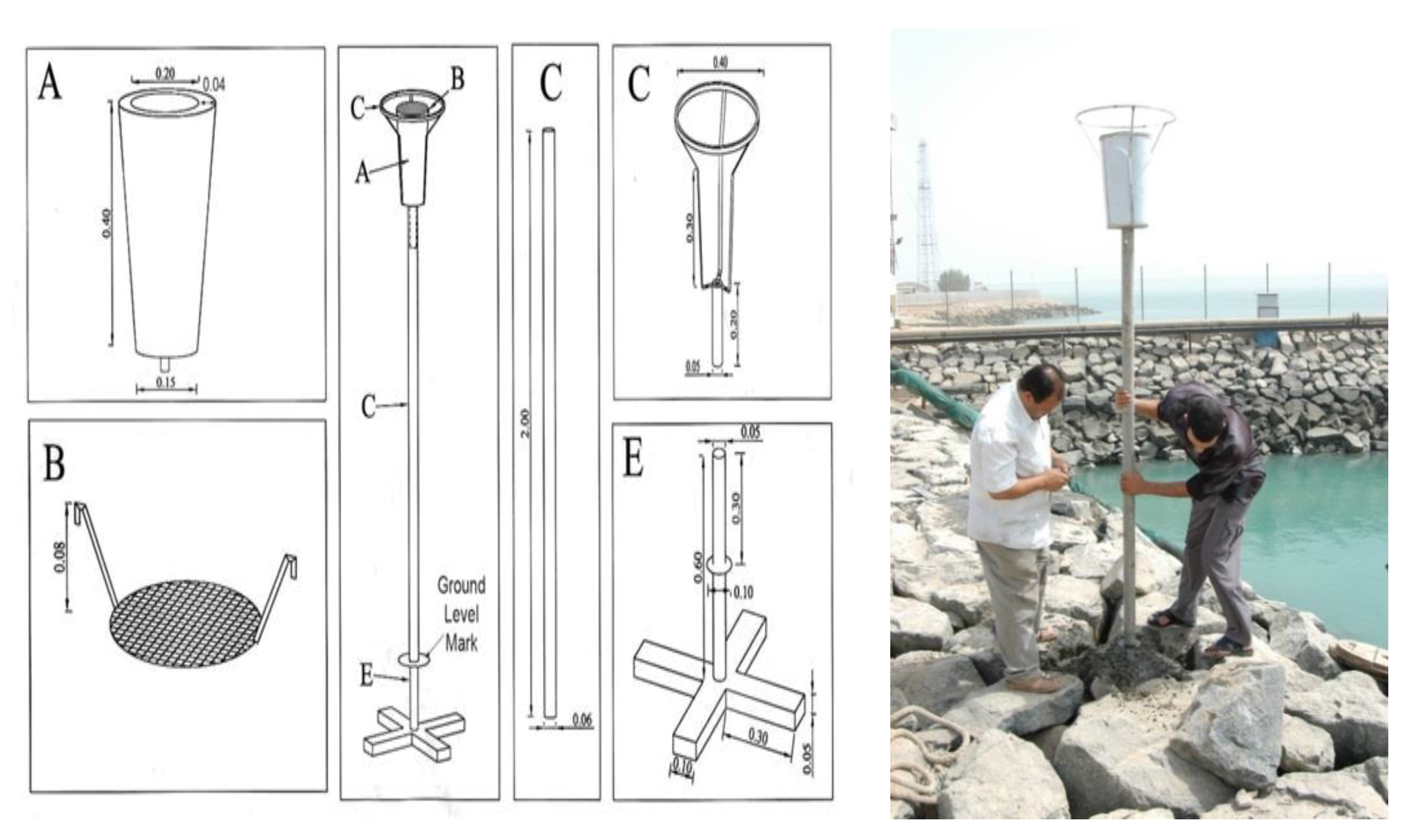
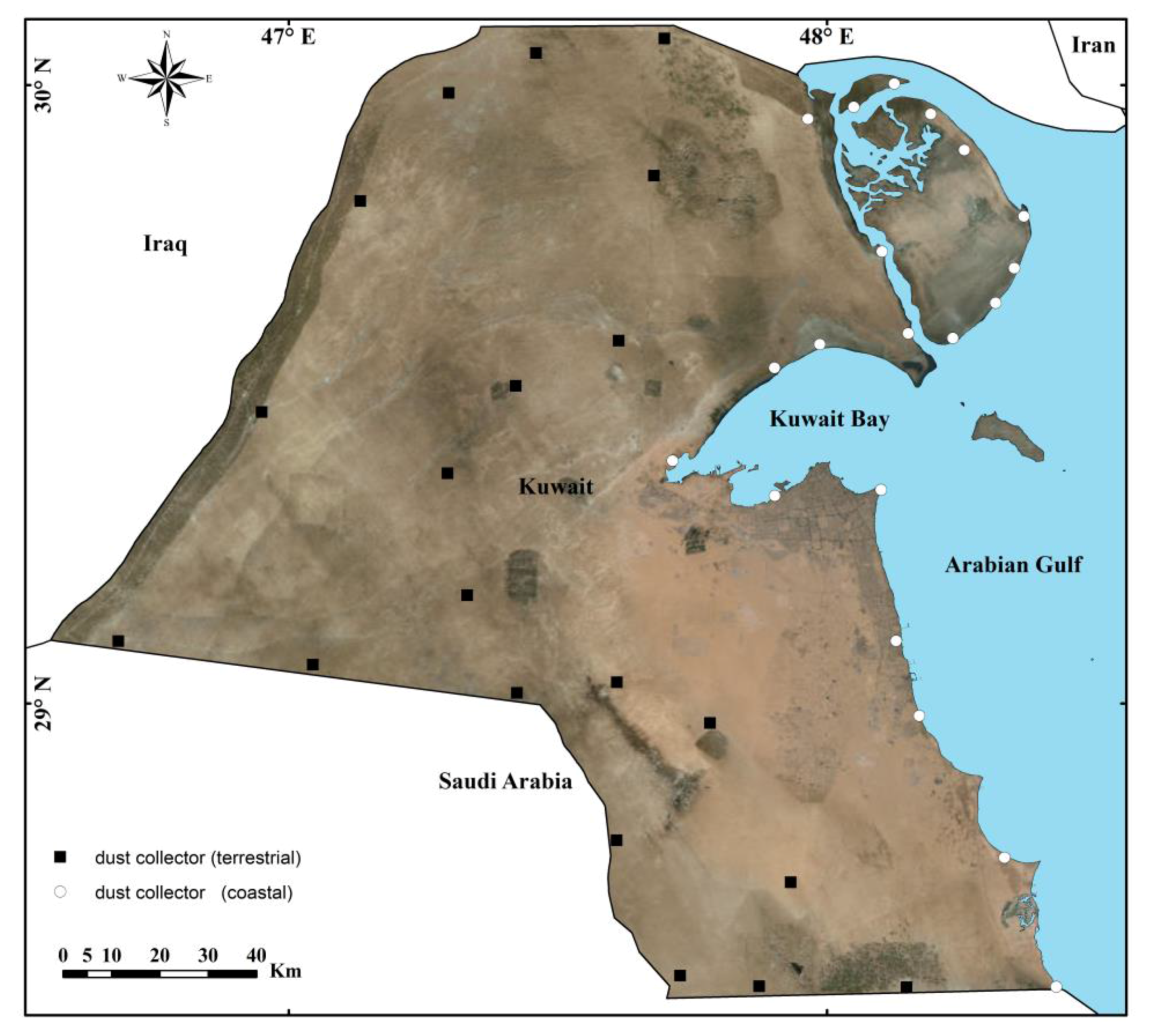
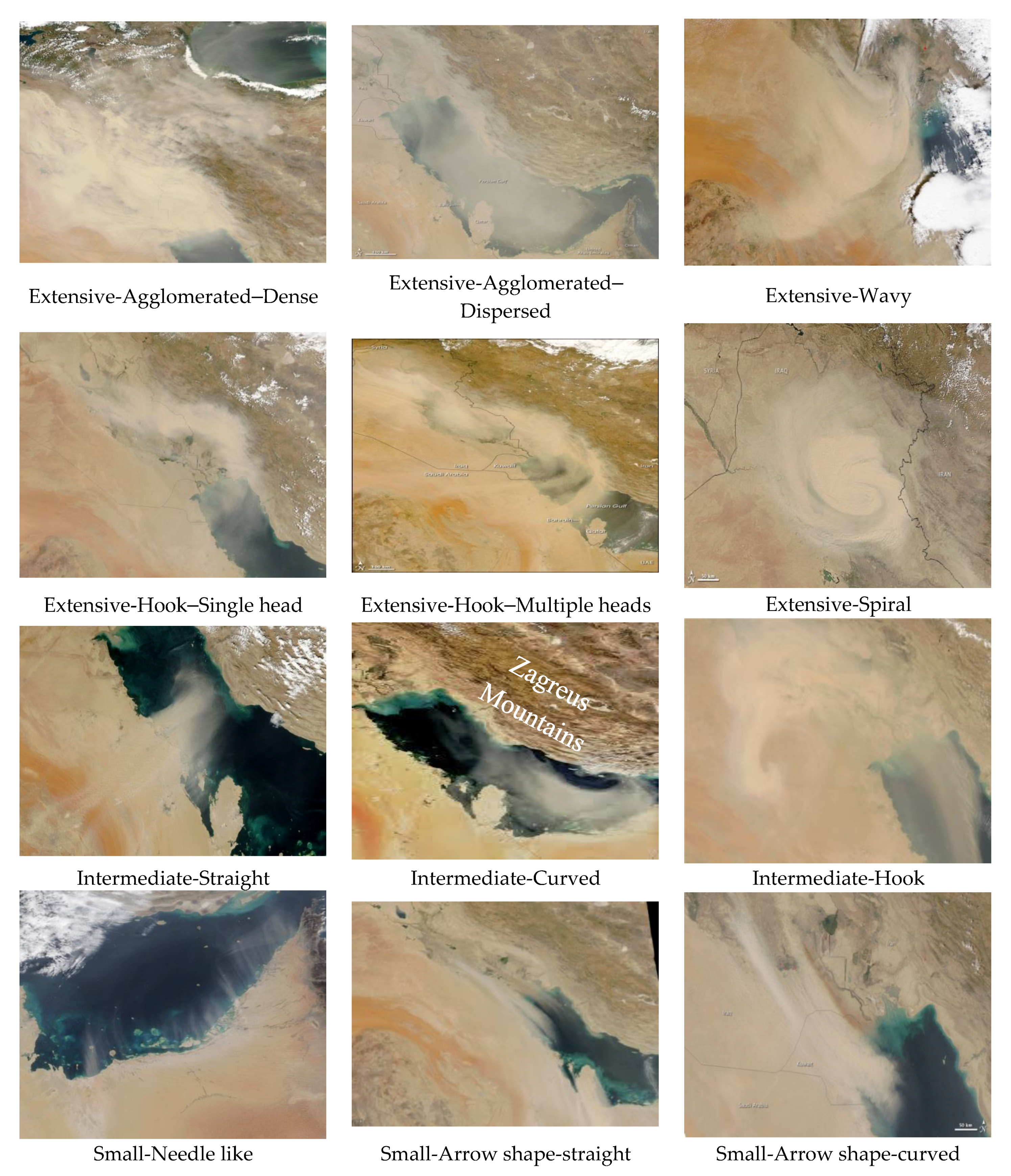
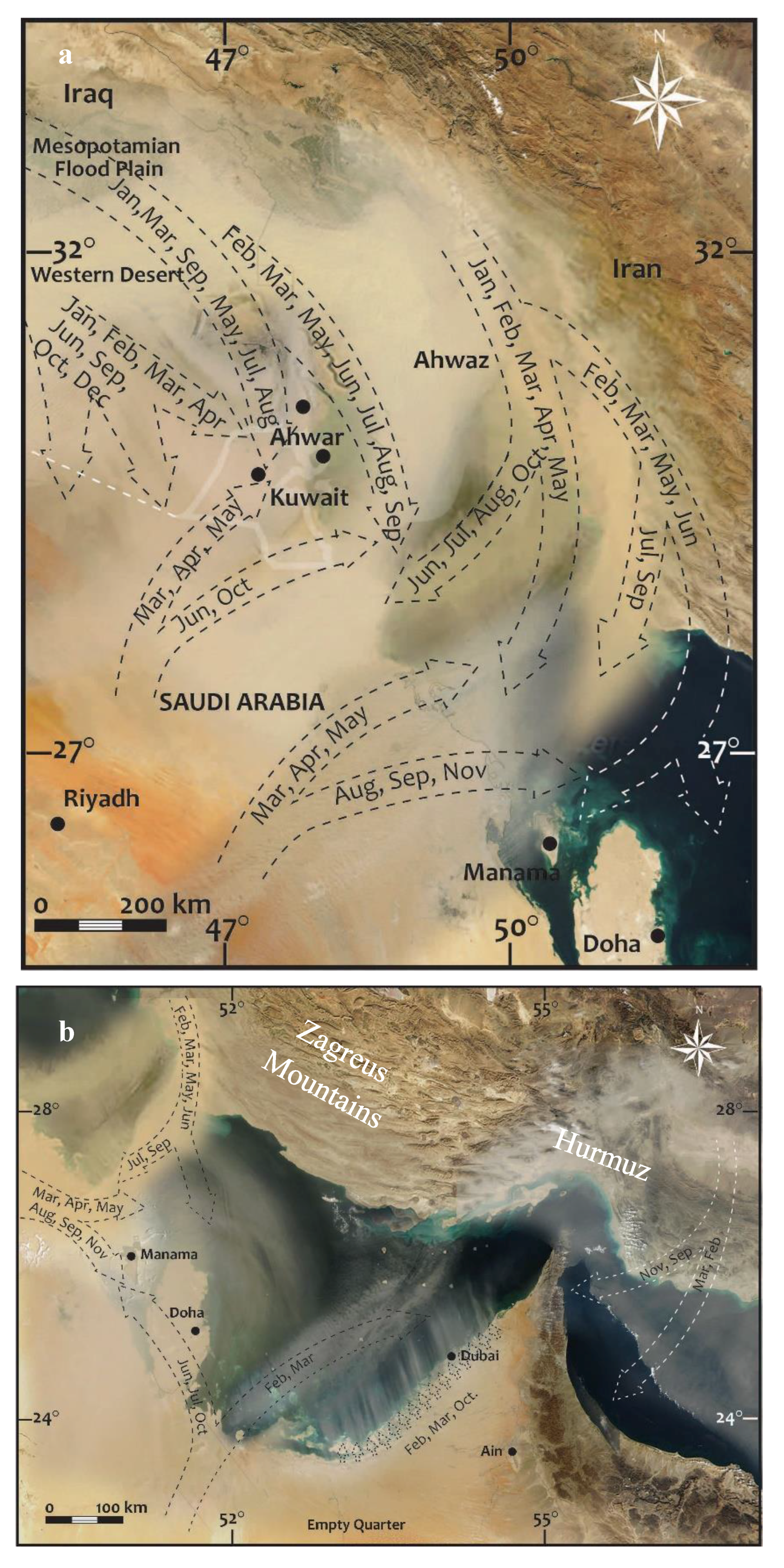
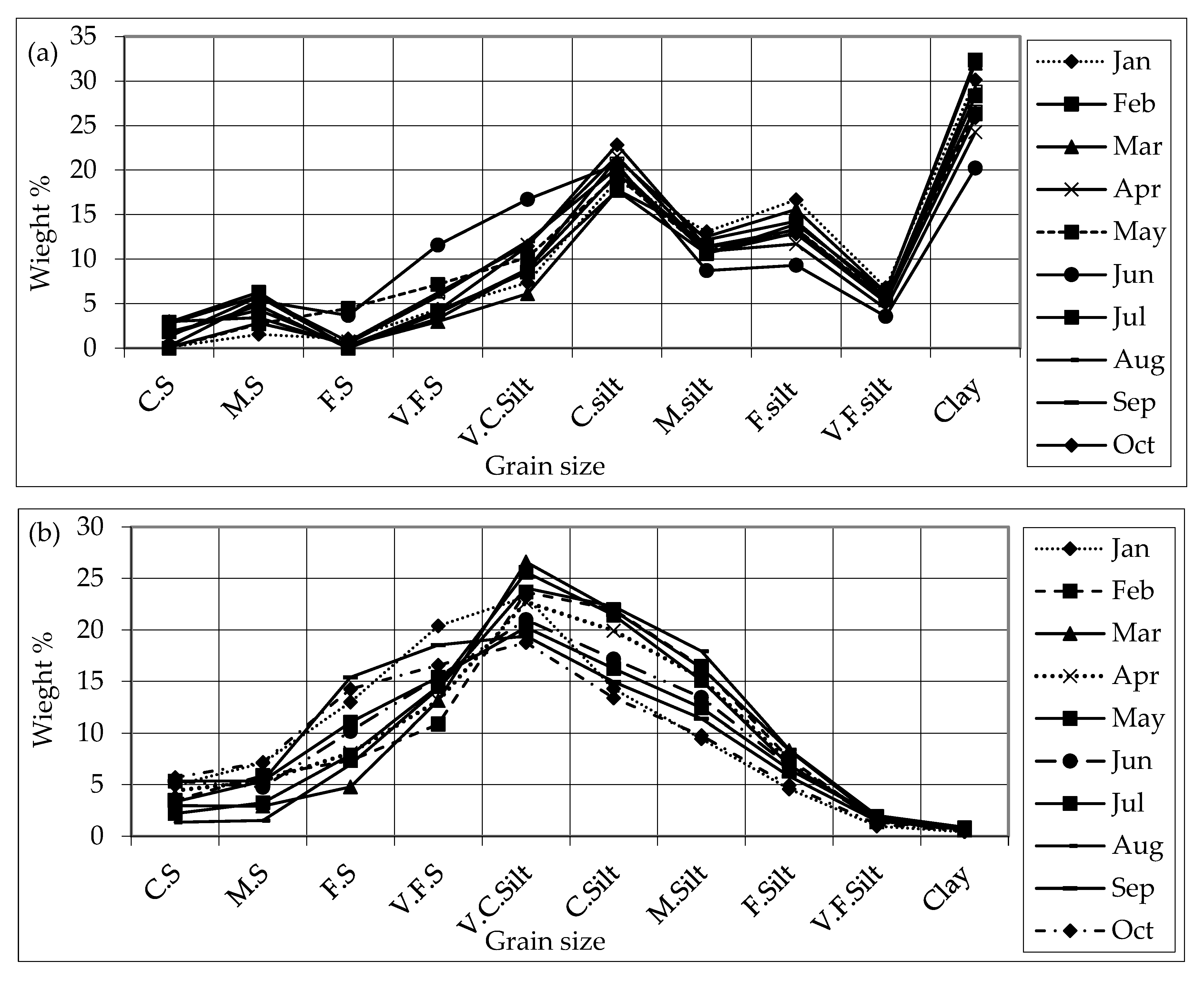
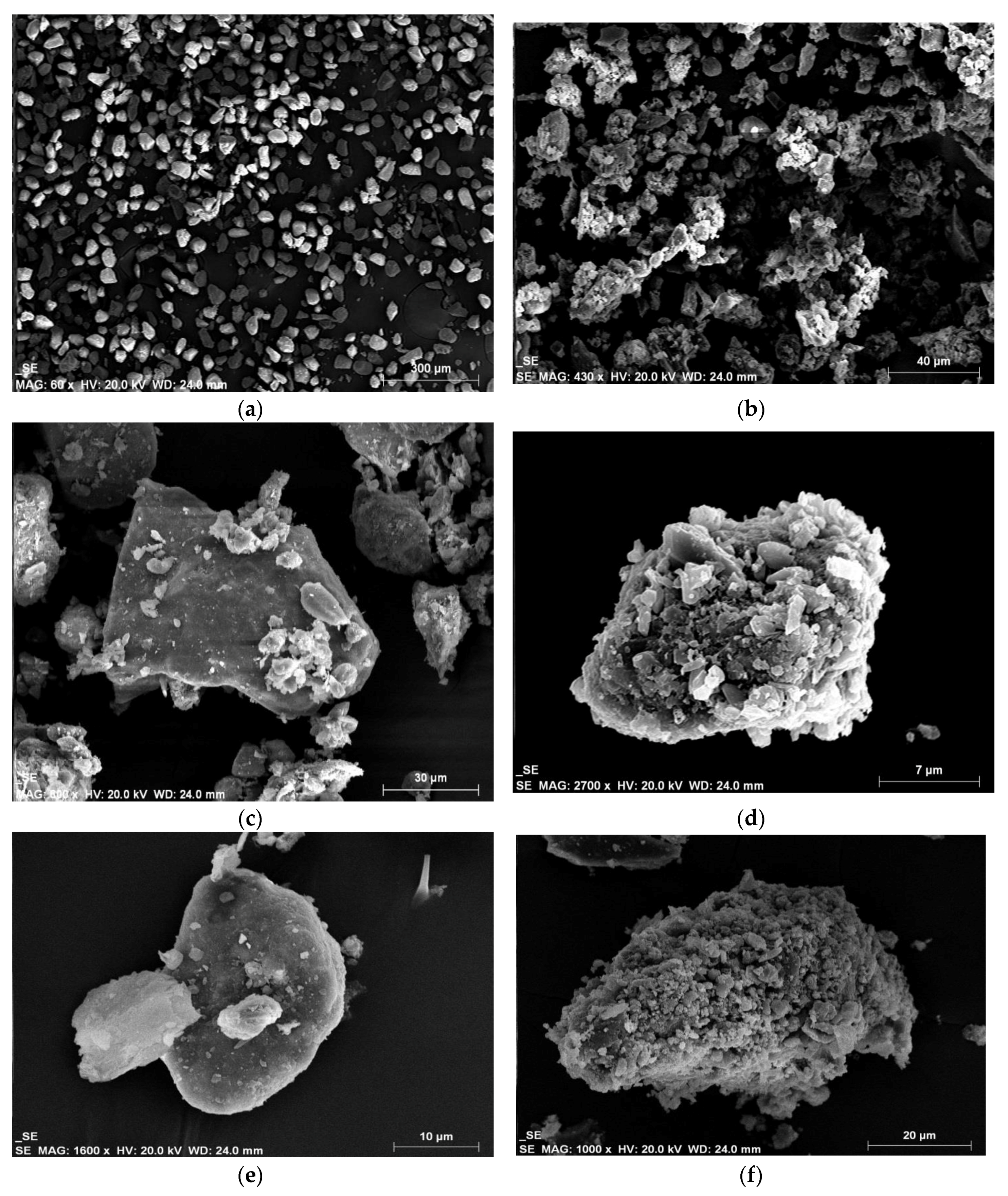

| Cities | Year | Jan | Feb | Mar | Apr | May | Jun | Jul | Aug | Sep | Oct | Nov | Dec | Annual Average |
|---|---|---|---|---|---|---|---|---|---|---|---|---|---|---|
| Kuwait | 17 | 0.9 | 1.2 | 1.1 | 3.3 | 3.7 | 4.4 | 4.5 | 1.9 | 0.6 | 1.4 | 0.3 | 1.1 | 21 |
| Riyadh | 5 | 2.2 | 4.4 | 5.6 | 10 | 6.2 | 8.4 | 5.2 | 2.2 | 1.2 | 0.6 | 1.8 | 1.0 | 49 |
| Bahrain | 33 | 0.1 | 0.3 | 0.5 | 0.6 | 0.5 | 1.4 | 1.5 | 0.2 | 0.3 | 0.0 | 0.1 | 0.1 | 5.6 |
| Doha | 15 | 0.4 | 0.5 | 0.7 | 0.7 | 0.4 | 1.7 | 1.4 | 0.4 | 0.4 | 0.3 | 0.4 | 0.1 | 7.6 |
| Abu-Dhabi | 6 | 0.4 | 0.3 | 0.6 | 0.1 | 0.4 | 0.4 | 0.7 | 0.0 | 0.0 | 0.0 | 0.2 | 0.7 | 3.9 |
| Ocean/Sea | Total Area (km2) | Annual Dust (t km−2) | Location-Political Region (Reference) | Annual Dust to Total Sea Area (Million Tons) * | Annual Dust in Water Volume (t km−3) ** |
|---|---|---|---|---|---|
| Arabian Gulf | 226,000 | 373 | Kuwait (present study) | 89 | 10,330 |
| 76 | Um Qasr-Iraq [12] | ||||
| 194 | Khur Zubir [12] | ||||
| 392 | Nufud [30] | ||||
| Arabian Sea | 3,862,000 | 89 | Oman [31] | 344 | 33 |
| Red Sea | 938,000 | 57 | Negev Desert [32] | 53 | 1.33 |
| Mediterranean Sea | 2,500,000 | 155 | Tripolli-Libya [33] | 185 | 49 |
| 10 | Crete-Greece [34] | ||||
| Atlantic Ocean | 106,400,000 | 114 | Agadir-Morocco [35] | 13,324 | 38 |
| 145 | Sidi Afni-Morocco [35] | ||||
| 175 | Tan Tan-Morocco [35] | ||||
| 111 | Smara-Morocco [35] Itguity- | ||||
| 40 | Morocco [35] | ||||
| 52 | Layoune-Morocco [35] | ||||
| 219 | Boujdour-Morocco [35] | ||||
| 191 | Dakhla-Mauritania [35] | ||||
| 80 | Noudhibou-Mauritania [35] |
| Location | Sand | V. C. Silt * | C. Silt * | M. Silt * | F. Silt * | V. F. Silt * | Clay |
|---|---|---|---|---|---|---|---|
| Desert dust around the Arabian Gulf | |||||||
| Walameen-Saudi | 40 | 8 | 21 | 15 | 11 | 2 | 4 |
| Ain, UAE | 97 | 0 | 1 | 1 | 1 | 1 | 0 |
| Kuwait desert | 37 | 22 | 18 | 14 | 7 | 2 | 0 |
| Coastal dust around the Arabian Gulf | |||||||
| Ahwar, Iraq | 3 | 12 | 20 | 25 | 15 | 5 | 20 |
| Kuwait coast | 12 | 10 | 20 | 11 | 13 | 5 | 28 |
| Bahrain | 12 | 10 | 20 | 11 | 13 | 5 | 28 |
| Dubai, Emirate | 17 | 3 | 14 | 24 | 23 | 10 | 8 |
| Mean (Desert) | 58 | 10 | 13 | 10 | 6 | 2 | 1 |
| Mean (Coastal) | 11 | 9 | 19 | 18 | 16 | 6 | 21 |
| Sector | Area | Source | Quartz | Calcite | Dolomite | Carbonates | Feldspars | Clay | Others |
|---|---|---|---|---|---|---|---|---|---|
| Desert dust-Arabian Gulf | |||||||||
| Riyadh | Saudi | [37,38] | 68 | 32 | 0 | 32 | 0 | 0 | 0 |
| Walameen | Saudi | Present study | 62 | 13 | 0 | 13 | 24 | 1 | 0 |
| Doha | Qatar | Present study | 48 | 21 | 7 | 28 | 24 | 0 | 0 |
| Ain | Emirate | Present study | 26 | 34 | 19 | 52 | 20 | 1 | 0 |
| Desert | Kuwait | Present study | 39 | 26 | 11 | 37 | 12 | 5 | 6 |
| Coastal dust-Arabian Gulf | |||||||||
| Coastal | Kuwait | Present study | 28 | 20 | 14 | 34 | 18 | 5 | 14 |
| Ahwar | Iraq | Present study | 36 | 30 | 11 | 42 | 8 | 5 | 9 |
| Dubai | U.A.E | Present study | 21 | 25 | 21 | 45 | 6 | 0 | 27 |
| Manama | Bahrain | Present study | 32 | 25 | 16 | 41 | 10 | 3 | 15 |
| Mean (Desert) | 49 | 25 | 7 | 32 | 16 | 1 | 1 | ||
| Mean (Coastal) | 29 | 25 | 16 | 41 | 11 | 3 | 16 | ||
© 2017 by the authors. Licensee MDPI, Basel, Switzerland. This article is an open access article distributed under the terms and conditions of the Creative Commons Attribution (CC BY) license (http://creativecommons.org/licenses/by/4.0/).
Share and Cite
Al-Dousari, A.; Doronzo, D.; Ahmed, M. Types, Indications and Impact Evaluation of Sand and Dust Storms Trajectories in the Arabian Gulf. Sustainability 2017, 9, 1526. https://doi.org/10.3390/su9091526
Al-Dousari A, Doronzo D, Ahmed M. Types, Indications and Impact Evaluation of Sand and Dust Storms Trajectories in the Arabian Gulf. Sustainability. 2017; 9(9):1526. https://doi.org/10.3390/su9091526
Chicago/Turabian StyleAl-Dousari, Ali, Domenico Doronzo, and Modi Ahmed. 2017. "Types, Indications and Impact Evaluation of Sand and Dust Storms Trajectories in the Arabian Gulf" Sustainability 9, no. 9: 1526. https://doi.org/10.3390/su9091526





